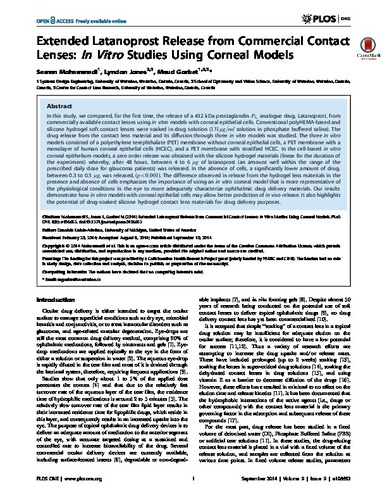| dc.contributor.author | Mohammadi, Saman | |
| dc.contributor.author | Jones, Lyndon W. | |
| dc.contributor.author | Gorbet, Maud | |
| dc.date.accessioned | 2017-03-07 19:47:56 (GMT) | |
| dc.date.available | 2017-03-07 19:47:56 (GMT) | |
| dc.date.issued | 2014-10-09 | |
| dc.identifier.uri | http://hdl.handle.net/10012/11457 | |
| dc.identifier.uri | http://dx.doi.org/10.1371/journal.pone.0106653 | |
| dc.description | Mohammadi, S., Jones, L., & Gorbet, M. (2014). Extended Latanoprost Release from Commercial Contact Lenses: In Vitro Studies Using Corneal Models. PLoS ONE, 9(9), e106653. https://doi.org/10.1371/journal.pone.0106653 | en |
| dc.description.abstract | In this study, we compared, for the first time, the release of a 432 kDa prostaglandin analogue drug, Latanoprost, from commercially available contact lenses using in vitro models with corneal epithelial cells. Conventional polyHEMA-based and silicone hydrogel soft contact lenses were soaked in drug solution ( solution in phosphate buffered saline). The drug release from the contact lens material and its diffusion through three in vitro models was studied. The three in vitro models consisted of a polyethylene terephthalate (PET) membrane without corneal epithelial cells, a PET membrane with a monolayer of human corneal epithelial cells (HCEC), and a PET membrane with stratified HCEC. In the cell-based in vitro corneal epithelium models, a zero order release was obtained with the silicone hydrogel materials (linear for the duration of the experiment) whereby, after 48 hours, between 4 to 6 of latanoprost (an amount well within the range of the prescribed daily dose for glaucoma patients) was released. In the absence of cells, a significantly lower amount of drug, between 0.3 to 0.5 , was released, (). The difference observed in release from the hydrogel lens materials in the presence and absence of cells emphasizes the importance of using an in vitro corneal model that is more representative of the physiological conditions in the eye to more adequately characterize ophthalmic drug delivery materials. Our results demonstrate how in vitro models with corneal epithelial cells may allow better prediction of in vivo release. It also highlights the potential of drug-soaked silicone hydrogel contact lens materials for drug delivery purposes. | en |
| dc.description.sponsorship | The funding for this project was provided by a Collaborative Health Research Project grant (jointly funded by NSERC and CIHR). | |
| dc.language.iso | en | en |
| dc.publisher | Public Library of Science | en |
| dc.rights | Attribution 4.0 International | * |
| dc.rights.uri | https://creativecommons.org/licenses/by/4.0/ | * |
| dc.subject | Cornea | en |
| dc.subject | Gels | en |
| dc.subject | Lens (anatomy) | en |
| dc.subject | Epithelial cells | en |
| dc.subject | Silicones | en |
| dc.subject | Drug metabolism | en |
| dc.subject | Cell metabolism | en |
| dc.subject | Drug delivery | en |
| dc.title | Extended Latanoprost Release from Commercial Contact Lenses: In Vitro Studies Using Corneal Models | en |
| dc.type | Article | en |
| dcterms.bibliographicCitation | Mohammadi, S., Jones, L., & Gorbet, M. (2014). Extended Latanoprost Release from Commercial Contact Lenses: In Vitro Studies Using Corneal Models. PLoS ONE, 9(9), e106653. https://doi.org/10.1371/journal.pone.0106653 | en |
| uws.contributor.affiliation1 | Faculty of Science | en |
| uws.contributor.affiliation2 | School of Optometry and Vision Science | en |
| uws.typeOfResource | Text | en |
| uws.peerReviewStatus | Reviewed | en |
| uws.scholarLevel | Faculty | en |


